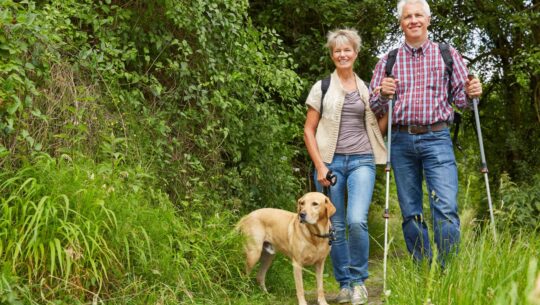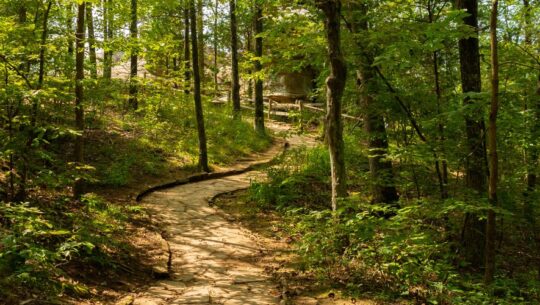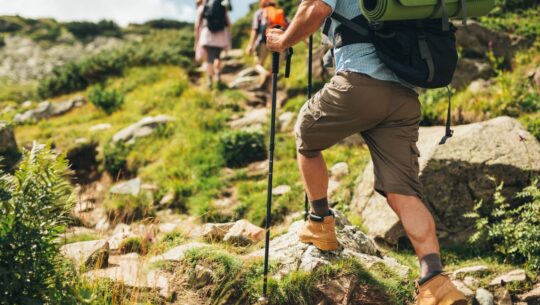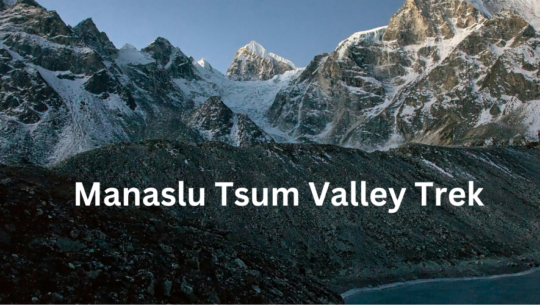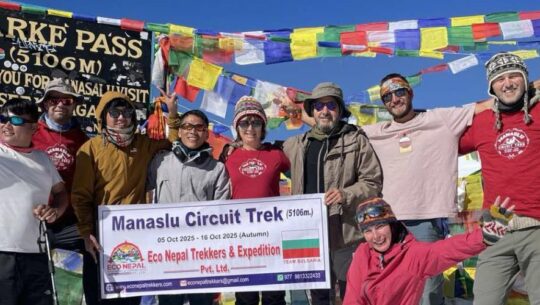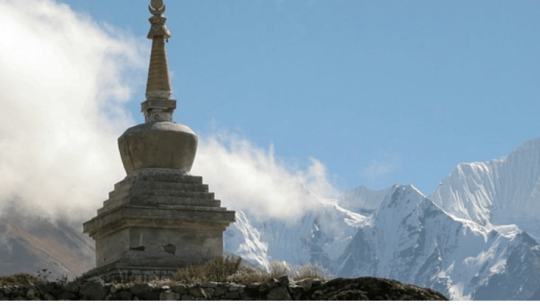Phulchowki Hiking From Kathmandu | One Day Hike Package 2025/26
TripAdvisor Reviews Recommended by 99.99% travelers
USD 250
Nepal
1 Day
Normal
2,762 meters at Phulchowki Summit
Not Included
private vehicle
1-50
Feb, Mar, Apri, May, June, Sep, Oct, Nov & Dec.
- Phulchowki Day Hiking takes you to Kathmandu Valley’s highest hill at 2,762 meters in elevation.
- The “Hill of Flowers” hosts over 300 bird species, including Nepal’s endemic Spiny Babbler.
- Summit views include Annapurna, Manaslu, Langtang, and possibly Mount Everest on clear days.
- Complete the entire adventure in just 5-8 hours, perfect for a single-day trip.
- Trek through ancient Godawari forests with diverse flora from subtropical to temperate zones.
- Visit sacred sites like Godawari Kunda, Naudhara Temple, and Phulchowki Mai Temple.
- Spring brings spectacular rhododendron blooms while autumn offers the clearest mountain visibility.
- Spot rare wildlife, including Barking Deer, Langur Monkeys, and hundreds of butterfly species.
- No complicated permits needed, just basic entrance fees to the Godawari Botanical Garden area.
- Professional guide, private transport, and all permits included in the comprehensive package.
Phulchowki Hiking From Kathmandu | One Day Hike Package 2025/26 Brief Insight
Did you know Phulchowki Danda at 2,762 meters (9,127 feet) is the highest hill surrounding the entire Kathmandu Valley?
However, it’s not only the highest, but it’s also the one that’s always covered in flowers.
In fact, the name “Phulchowki” literally means “Hill of Flowers” in Nepali. Poetic, right?
Talking about the distance, it is just 20 kilometers southeast of Kathmandu, which takes around 1.5 to 2 hours to drive on a typical day.
And to reach the summit of Phulchowki Danda, you’ll walk through Godawari forests, spot rare birds (over 300 species), and visit sacred places like Naudhara.
As a matter of fact, Phulchowki is home to Nepal’s only native bird species, the Spiny Babbler.
So, keep your eyes open as you might see the rarest of birds during this hike.
Why Should You Choose Phulchowki Hiking?
If you are still not convinced about why Phulchowki should be your next destination, let us provide you with more reasons.
Unbeatable Mountain Views
From the summit, on clear days, you’ll see some of Nepal’s most famous peaks.
We’re talking about Annapurna (8,091m), Manaslu (8,165m), Ganesh Himal (7,446m), Langtang Lirung (7,245m), and Gaurishankar (7,134m).
And if you’re lucky with the weather, you might see little parts of Mount Everest (8,848m) in the eastern horizon. Sounds fantastic, right?
Just imagine the view of the mountain in the distance, and the entire Kathmandu valley just below your eyes.
Phulchowki Danda Hosts Over 300 Species of Birds
Now, here is something for birdwatchers!
Phulchowki is Nepal’s premier bird-watching destination within the Kathmandu Valley, with over 300 documented bird species.
Additionally, this hill is home to the Spiny Babbler (Turdoides nipalensis), Nepal’s only endemic bird species. You won’t find this bird anywhere else in the world!
Furthermore, you might also spot other incredibly rare bird species, which include Himalayan Cutia, Red-headed Trogon, Rufous-bellied Niltava, Verditer Flycatcher, Mountain Hawk-Eagle, Grey-headed Woodpecker, and Yellow-browed Tit.
However, don’t let the birds fool you, as the hill itself creates the perfect habitats for wildlife such as Barking deer, Langur Monkeys, and seasonal butterflies.
Phulchowki Danda Offers Tons of Cultural Sites
For generations, Phulchowki Danda has been an important route to visit several religious spots.
In fact, right during the time of entrance, you can visit Godawari Kunda, a holy spring with five dragon-head water spouts where pilgrims are known to perform ritual baths.
Next comes the Naudhara Temple, featuring nine traditional water taps built during the Rana period and dedicated to the tantric mother goddess.
As you reach the summit, you’ll also find the Phulchowki Mai Temple, decorated with colorful prayer flags that represent both Buddhist and Hindu traditions.
Perfect One-Day Adventure
Here’s the best part! Unlike multi-day treks that require weeks of planning and preparation, Phulchowki can be completed comfortably in 5 to 8 hours.
You can leave early in the morning from Kathmandu and return by evening, without losing any sort of experiences.
Besides that, the trail passes through community forests managed by local villages, which showcase Nepal’s successful conservation model.
- Detailed Itinerary of Phulchowki Day Hiking
Detailed Itinerary
Detailed Itinerary of Phulchowki Day Hiking
Trek Distance :
30 km / 19 miles
Highest Altitude :
2,762 meters at Phulchowki Summit
Trek Duration :
1 Day (15 hours total, including travel)
Meals :
Not Included
Early Morning Departure (5:30 AM to 7:15 AM)
Your adventure starts at 5:30 AM when our professional guide picks you up from your hotel in Thamel.
We’ll load up the private vehicle and head east from Thamel towards Ratna Park via Tridevi Marg. Even at this early hour, you’ll see local vendors setting up their shops and the city slowly waking up.
Then, we will slowly head towards New Baneshwor, following the Araniko Highway. While passing through this area, you will see the remains of Singhadurbar (the important heritage that got destroyed during the Gen-Z protest).
Continuing our journey, we move forward to Jawalakhel and finally reach the Godawari Bus Park area.
Village Orientation and Trail Start (7:15 AM to 8:00 AM)
Godawari Bus Park Stop (7:15 AM)
At the bus park, you’ll find small shops, tea stalls, public toilets, and water taps. This is your last chance to buy any supplies you might have forgotten. The altitude here is 1,500 meters.
Walk to Godawari Kunda (7:30 AM)
From the bus park, we’ll walk 200 meters south towards the sacred water tank, following a stone-paved path.
Here’s what makes Godawari Kunda special. This rectangular stone tank measures 15 feet square and 10 feet deep, fed by five dragon-head water spouts called Pancha Dhara. Natural spring water flows constantly through these ancient stone carvings.
You’ll see pilgrims taking holy baths here and on the upper levels. The entire complex radiates spiritual energy.
Godawari Temple Complex (7:45 AM)
Next, we’ll continue west from the kunda to the main temple courtyard. Here, you can refill your water bottles from traditional water taps.
Around this area, you’ll also find Siddheshwar Mahadev cave temple, Vishnu Paduka shrine, and Gaurikund tucked away in the forest.
This is the first place where your ID documents and permits will be checked.
Trail starts from Temple’s Left Side (8:00 AM)
At 8:00 AM, we begin our actual hiking trail from the left side of Godawari Temple, heading south on a black-topped asphalt road.
Now, here’s something to note. The first kilometer is a paved road with a gradual uphill. It’s an easy warm-up for what’s coming ahead.
Then, you enter the famous Godawari Community Forest, which covers 147 hectares across four blocks.
Right at this moment, you are on the lower block where dominant trees are Schima wallichii (locally called Chilaune) with scattered Phoenix humilis.
Keep your eyes open for birds. This early in the morning, you’ll likely spot Oriental Magpie-robin, Common Tailorbird, and Jungle Myna.
Through the Forest Sections (8:45 AM to 12:30 PM)
End of Asphalt to Stone Steps (8:45 AM)
After 45 minutes of walking, the asphalt road ends, and the real adventure begins.
You’ll transition to a stone staircase system that’s been built as shortcuts through the forest.
At this point, you’ll reach the First Rest Point, a concrete platform with stone benches. The altitude here is 1,580 meters.
From here, the trail alternates between stone steps and forest paths, occasionally crossing dirt roads. This is Block 1 of Godawari Community Forest.
Dense Forest Section (9:30 AM)
The section that we will enter during this time period is called the Godawari-Naudhara Community Forest Section. Here, the tree composition changes, as trees like Castanopsis indica become more common alongside other species like Engelhardtia spicata and Macaranga pustulata.
If you are interested in seeing wildlife, this is the perfect spot to find it.
To find one, you need to watch the ground for Barking Deer tracks, and look up to spot Langur monkeys.
Furthermore, if you are really lucky, you might also hear the distinctive call of the Lesser Racket-tailed Drongo.
Naudhara Temple and 9-Spout Complex (10:15 AM)
After another 45 minutes of hiking, you’ll arrive at one of the trail’s religious landmarks, Naudhara Temple.
The temple is visible on the left side of the trail and is dedicated to Naudhara Mai, a tantric mother goddess.
Fun fact: The nine taps in the temple represent nine streams flowing down from Phulchowki. The entire complex was built during the Rana era by Juddha Shumsher to provide a community water supply.
Local people even hold marriage ceremonies here, making it both a spiritual and social gathering place.
There’s a stone seating area near the temple complex where you can rest, refill your water bottles (purification recommended), and catch your breath.
Naudhara to Mid-Elevation Forest (11:00 AM)
From Naudhara, the trail continues uphill towards a section called Latta Bhanjyang. This is where the trail starts getting steep. The best idea for this section is to pace yourselves.
Moreover, this section that you’re in is Block 2 of the Mid-elevation Community Forest Section. The altitude here ranges from 1,700 to 1,900 meters, and the forest composition changes noticeably.
Castanopsis tribuloides becomes the dominant tree species, and you’ll start seeing Rhododendron arboreum appearing.
As the trail becomes more challenging, we will take frequent breaks here.
Latta Bhanjyang Traditional Pass (11:45 AM)
Latta Bhanjyang is a traditional mountain pass, a saddle between ridges. You’ll find the Second Major Rest Point here with prayer stones and log seating.
At 1,900 meters, this area is prime habitat for the Spiny Babbler, a bird species only found in Nepal. If you’re lucky and quiet, you might spot one!
This section is designated as the Mid-Hill Broadleaf Forest Block, showcasing the incredible biodiversity that makes Phulchowki famous.
Prayer Flag Area – Jhanda Sthal (12:30 PM)
After another 45 minutes of uphill hiking, you’ll reach one of Phulchowki’s most photogenic spots, the Prayer Flag Area, locally known as Jhanda Sthal.
This extensively decorated area features colorful Buddhist and Hindu prayer flags fluttering in the mountain breeze. On the left side of the road, there’s a small pond and a shrine area.
At 2,100 meters altitude, this marks a sacred transition zone, your spiritual approach to the summit. The stone benches here are perfect for a rest, and the mountain sighting during clear weather provides excellent photo opportunities.
The atmosphere here is peaceful and contemplative. Many hikers spend extra time at this spot, soaking in the spiritual energy.
Final Summit Push (1:15 PM to 2:15 PM)
The Most Challenging Section (1:15 PM)
From the Prayer Flag Area, you begin the most challenging section of the entire hike. The final 600 meters of elevation gain covers about 4 kilometers of trail.
This is the steepest part, covering 450 meters of altitude gain. The forest here is designated as a High-altitude Oak Forest Block.
The dominant tree species changes to Quercus semicarpifolia (oak), with Rhododendron shrubs and Juniper species scattered throughout.
Furthermore, the air becomes noticeably thinner. If this is your first hiking experience, then you need to pace yourself.
Along the way, you’ll pass two more rest points. Rocky Outcrop Rest at 2,350 meters and High Forest Clearing at 2,500 meters. Use these spots to catch your breath and hydrate.
Nepal Army Checkpoint (2:00 PM)
At 2,750 meters, just before the summit, you’ll reach the Phulchowki Army Post. This is a mandatory registration point, so have your ID documents ready.
The Nepal Army guards here protect the telecommunications installations at the summit. They’re friendly and professional, and the registration process is quick.
Here’s some good news. There’s an Army Canteen here where you can buy tea, coffee, cookies, and soup. It’s a welcome break before the final push.
Summit of Phulchowki Danda (2:15 PM)
And finally, you’ve made it! At 2,762 meters (9,127 feet), you’re standing at the highest point of Phulchowki Danda.
The summit features several landmarks. Phulchowki Mai Temple, the mother goddess shrine, is adorned with tridents and prayer flags. The NTV Tower Complex with Nepal Television transmission towers. Army Communication Posts for military installations. And the Main Viewpoint Platform offering 360-degree views.
Summit Experience (2:15 PM to 3:15 PM)
Now comes the moment you’ve been waiting for. The views!
On clear days, here’s what you’ll see:
Looking West: The massive Annapurna Range, Manaslu standing tall at 8,165 meters, and Ganesh Himal reaching 7,446 meters.
Looking North: Langtang Lirung at 7,245 meters and the entire Langtang Range stretching across the horizon.
Looking East: Jugal Himal, Gaurishankar at 7,134 meters, and if the weather is perfect, Mount Everest at 8,848 meters!
Central View: Dorje Lakpa and Phurbi Gyachu peaks complete the spectacular panorama.
Below you, the entire Kathmandu Valley spreads out like a detailed map. You can identify Kathmandu, Lalitpur, and Bhaktapur cities, along with countless villages, temples, and rice terraces.
This is your time to explore. Visit the temple and offer prayers if you wish. Take photographs from different angles. Enjoy your packed lunch while soaking in the views.
And keep your eyes open for summit birds like White-collared Blackbird, Dark-throated Thrush, and Hodgson’s Redstart.
Most hikers spend about one hour at the summit. It’s a moment of achievement, reflection, and pure joy.
Return Journey (3:15 PM to 7:30 PM)
Beginning the Descent (3:15 PM)
At 3:15 PM, we’ll start our return journey following the exact same route. Heading north from the summit towards the army checkpoint, the descent typically takes about 4 hours.
Here’s something interesting about the descent. The afternoon brings different wildlife activity. You’ll likely spot Fire-tailed Sunbird and Red-flanked Bluetail, which become more active in the late afternoon.
Army Checkpoint to Prayer Flags (4:00 PM to 4:45 PM)
We’ll pass through the army checkpoint again. If you need any final refreshments, the canteen is available.
By 4:45 PM, we’ll reach the Prayer Flag Area (Jhanda Sthal) for a brief rest. The afternoon atmosphere here is completely different from the morning. The forest sounds change, and you’ll hear Laughingthrushes and Babblers calling from the trees.
Through Latta Bhanjyang (5:30 PM)
Passing through the Latta Bhanjyang area in the evening offers a different perspective. The evening bird activity picks up with Long-tailed Drongo and various Warbler species moving through the trees.
Naudhara Temple Area (6:15 PM)
We’ll pass the Naudhara Kunda and temple complex again. The evening atmosphere here is peaceful, with fewer visitors. Some locals might be collecting water for their evening rituals.
Stone Steps to Godawari (6:45 PM to 7:15 PM)
The descent down the stone staircase is easier on your lungs but requires careful footing. Take your time on the steps to avoid any slips.
By 7:15 PM, you’ll arrive back at the Godawari Temple Complex, where we started. Use the facilities here for water refills, restroom breaks, and final refreshments.
Your total hiking time will be approximately 8 hours (6 hours up, 2 hours down). Well done! You’ve conquered Phulchowki Danda!
Drive Back to Thamel (7:30 PM to 8:30 PM)
At 7:30 PM, we’ll load back into our vehicle and begin the return journey to Kathmandu.
The route follows Godawari to Satdobato to Jawalakhel to Ring Road to New Baneshwor to Thamel. The total distance is 18 kilometers, taking 45 to 60 minutes depending on evening traffic.
By 8:30 PM, we’ll drop you back at your hotel in Thamel. Your total door-to-door experience time is 15 hours.
As you settle back into your hotel, you’ll carry memories of ancient forests, sacred temples, rare birds, and those incredible Himalayan mountain views. Not a bad day’s work, right?
Cost Includes
- Professional and well-trained English-speaking guide for the entire day
- Comfortable private transportation from Kathmandu to Godawari and back
- All ground transportation coordination
- Godawari Botanical Garden entrance fees
- Temple and cultural site entrance fees
- Forest trail entrance permits and registrations
- Army checkpoint registration assistance
- Mineral water during the hike (2 liters per person)
- Fresh fruits during rest stops
- First aid kit and safety equipment
- Photography assistance throughout the day
- Government taxes and service charges
- Pick-up and drop-off at your Thamel hotel
Cost Excludes
- Lunch and snacks during the tour (available for purchase at the army canteen)
- Personal drinks and beverages
- Travel insurance (strongly recommended)
- Personal expenses and shopping
- Tips for guide and driver (optional but appreciated)
- Any activities not mentioned in the itinerary
- Emergency evacuation costs if required
Best Time to Visit Phulchowki Danda
Timing is everything when it comes to hiking, right? Let us break down the seasons for you.
Spring (March to May)
If you want to experience Phulchowki at its absolute best, plan your visit during spring.
Here’s what makes spring special. The famous rhododendron forests bloom in spectacular displays of white and red colors.
The temperatures are perfect, ranging from 10 to 20°C during the day.
Yes, you’ll need a light jacket for early morning, but the hiking conditions are incredibly comfortable.
Rainfall is minimal, with just occasional showers. The skies remain predominantly clear, giving you excellent chances for those Himalayan mountain views.
Besides that, spring is the peak season for bird activities and butterfly migrations.
Autumn (September to November)
Autumn provides the second-best window for Phulchowki hiking, and many experienced hikers actually prefer this season.
The weather patterns are extremely stable with comfortable temperatures averaging 8 to 18°C.
But here’s what makes autumn truly special. The post-monsoon air clarity provides the clearest mountain visibility of the entire year. Your chances of seeing Mount Everest from the summit are highest during these months.
Furthermore, autumn is festival season in Nepal! You may experience Dashain celebrations and traditional cultural festivities that offer you a deeper insight into local traditions.
The post-harvest atmosphere in surrounding villages adds another cultural dimension to your hiking experience.
Winter (December to February)
Winter brings a completely different experience to Phulchowki. Daytime temperatures range from 13 to 15°C, but nights can drop to 3 to 4°C at the summit.
Occasionally, you’ll experience frost and fog that create mystical landscapes. And if you’re really lucky, you might even catch rare snowfall events like the one in February 2022.
The summit covered in fresh snow is absolutely magical. However, you’ll need to pack additional warm clothing and be prepared for potentially more challenging trail conditions.
Here’s something many people don’t know. Winter is actually an excellent time for bird watching as various species migrate to this area. The forest is quieter, with fewer crowds, creating a more peaceful experience.
For those who enjoy cozy experiences, the army checkpoint canteen becomes extra welcoming with hot tea and soup!
Summer / Monsoon (June to August)
Summer temperatures are actually quite pleasant, ranging from 21 to 27°C. However, expect plenty of rain. About 20 to 25 rainy days per month, to be exact.
Monsoon bird species and unique wildlife become active during this season. For serious nature photographers, this can be rewarding.
However, the trails become slippery and challenging. Visibility is often reduced due to clouds and rain. You’ll definitely need complete waterproof gear.
As a matter of fact, unless you’re an experienced hiker comfortable with challenging conditions, we’d recommend choosing spring or autumn instead.
Major Cultural Sites In Phulchowki
Just like the Chitlang Village tour, this day hiking tour also offers many cultural sites that you can visit.
Godawari Kunda (Sacred Spring)
This ancient sacred spring has been a pilgrimage site for centuries.
While visiting this spring, you will see five dragon-head water spouts (Pancha Dhara) continuously flow with natural spring water from underground sources.
The rectangular stone tank measures 15 feet square and 10 feet deep. Pilgrims perform ritual baths here, believing the water has purifying properties.
On the upper levels, you’ll find Pashupati and Jaleshwar Mahadev temples. The entire complex showcases traditional Nepali stone carving techniques.
Local legends say that bathing in these waters during specific festival days brings blessings and spiritual merit.
Phulchowki Mai Temple (Summit Shrine)
At the summit, the main temple is dedicated to the mother goddess. The shrine is decorated with tridents, prayer flags, and religious offerings from devotees.
Both Hindu and Buddhist traditions are represented here. The colorful prayer flags represent Buddhist practices, while the tridents and offerings follow Hindu customs.
This represents the beautiful religious harmony found throughout Nepal. Pilgrims of both faiths visit this temple, especially during festival seasons.
The temple becomes particularly crowded during the Phulchowki Mai festival when devotees climb to offer special prayers.
Key Wildlife and Bird Species Found In Phulchowki
Nepal’s OWN Bird: Spiny Babbler
The Spiny Babbler is about 23 to 25 cm long with dark brown plumage. It’s called “Kande Bhyakur” in Nepali. The bird prefers dense undergrowth in mid-elevation forests.
The best spotting areas are around Latta Bhanjyang and the mid-elevation forest sections between 1,700 to 2,000 meters.
Early morning hours provide the best chances as they’re most vocal during this time.
Other Spectacular Bird Species
Phulchowki hosts over 300 documented bird species. Some of the most spectacular ones include:
- Himalayan Cutia: A stunning bird with colorful plumage found in oak forests at higher elevations.
- Red-headed Trogon: One of Nepal’s most beautiful birds with brilliant red and yellow coloring.
- Rufous-bellied Niltava: A flycatcher species with vibrant blue and orange plumage.
- Verditer Flycatcher: Bright blue bird commonly seen catching insects mid-flight.
- Mountain Hawk-Eagle: Large raptor species occasionally spotted soaring above the forest.
- Grey-headed Woodpecker: Often heard drumming on tree trunks throughout the forest.
- Yellow-browed Tit: Small active bird found in mixed flocks at higher elevations.
- Fire-tailed Sunbird: Becomes active in the afternoons with metallic plumage, catching sunlight.
- White-collared Blackbird: Common at the summit area, with a distinctive white collar marking.
Besides that, you’ll encounter numerous species of Laughingthrushes, Warblers, Flycatchers, and Drongos throughout your hike.
Mammals and Other Wildlife
- Barking Deer: While sightings are rare, you’ll frequently see their tracks along the trail. These small deer are named for their distinctive bark-like alarm call.
- Himalayan Langur: Grey monkeys with long tails found in the forest canopy. They travel in troops and are often heard before being seen.
- Butterflies: Seasonal migrations bring hundreds of butterfly species, creating colorful displays, especially during spring.
- Himalayan Monal (Danphe): Nepal’s national bird, occasionally spotted at higher elevations, males have spectacular iridescent plumage.
The diverse habitats from subtropical to temperate zones create homes for countless other species, including insects, amphibians, and small mammals.
Fitness Level Required For Phulchowki Danda Hiking
Phulchowki requires moderate physical fitness. You should be able to walk continuously for 6 to 8 hours over varied terrain.
The trail gains 1,262 meters of elevation over approximately 6 to 7 kilometers one-way. This includes steep stone staircases, forest switchbacks, and occasional rocky sections.
Here’s the good news. Previous hiking experience is beneficial but not mandatory. However, mental preparation for sustained uphill effort is essential.
If you can climb 10 to 15 floors of stairs without excessive fatigue, you have sufficient fitness for this hike.
We recommend basic cardiovascular conditioning through regular walking or stair climbing 2 to 3 weeks before your hike date. This will make your experience much more enjoyable.
Necessary Preparations and Gear For Phulchowki Hiking
Physical Preparation
Start taking daily walks of at least 1 hour, 2 to 3 weeks before your hike. Include some uphill sections or stair climbing to prepare your legs for sustained climbing.
Stay well-hydrated in the days leading up to your hike. Proper hydration actually begins before you start hiking, not just during the trek.
Packing Checklist
- Footwear: Sturdy hiking boots with ankle support (broken-in before the hike, never new boots!). Bring camp shoes or sandals for rest stops.
- Clothing System: Follow the layering principle with a moisture-wicking base layer, insulating mid-layer (fleece or soft-shell), and waterproof outer shell.
- Head Protection: Sun hat with wide brim for sun protection, warm beanie for cold mornings, and a summit.
- Hand Protection: Lightweight gloves for general use, waterproof gloves for winter or wet conditions.
- Backpack: 25 to 35 liter capacity, comfortable with a hip belt for weight distribution.
- Trekking Poles: Highly recommended for stability on steep sections and reducing knee strain on descent.
- Sun Protection: Sunglasses with UV protection, sunscreen SPF 30 or higher, lip balm with SPF.
- Navigation: Map and compass (though the trail is well-marked), your phone with offline maps downloaded.
- Safety Items: Headlamp with extra batteries, whistle for emergency signaling, basic first aid kit.
- Hydration and Food: Minimum 2 liters of water (3 liters for hot weather), water purification tablets, energy-rich snacks.
Potential Hazards and Challenges
Trail Challenges
The steep terrain requires careful footing throughout. Pay attention to your steps, especially on stone staircases and during descent.
The weather can change quickly in the mountains. Even if it’s sunny at the base, summit conditions might be cold and windy. Always carry your warm and rain layers.
During the monsoon season, leeches can be present in lower forest sections. Wear long pants and use salt or insect repellent to prevent leech bites.
Wildlife Considerations
Wildlife encounters are generally minimal. However, maintain a respectful distance from Langur monkeys. Don’t feed them or try to touch them.
In lower elevations during warmer months, be aware of potential snake activity. Watch where you step and sit during rest breaks.
Limited Facilities
There are no shops, restaurants, or facilities along most of the trail. The only exception is the army checkpoint near the summit.
This means you must carry everything you need for the day. There are no bailout options once you start hiking.
Mobile phone coverage is limited in many forest sections. Don’t rely on your phone for emergency communication until you reach higher elevations.
Permits and Regulations For Phulchowki Hike
Required Permits
Good news! Phulchowki hiking doesn’t require complicated permit systems.
You’ll only need basic entry permits to the Godawari Botanical Garden area. No special trekking permits or TIMS (Trekkers Information Management System) cards are required. Phulchowki falls outside restricted trekking areas.
However, there are some entrance fees that need to be paid while visiting some places.
But if you are with us, our guide will handle all of these complications.
Hiking Restrictions
There are a few key restrictions you need to know:
- Mandatory Army Checkpoint Registration: Near the summit, you must stop at the Nepal Army checkpoint for registration. Have your ID documents ready.
- No Camping: Camping within the forest area is prohibited. This is a day-hike only destination.
- Wildlife Protection: Removing, damaging, or disturbing any flora or fauna is strictly prohibited with severe penalties for violations.
- Group Coordination: While group sizes are not limited, large groups should inform local authorities in advance for safety coordination.
Cultural Site Etiquette That You Can Follow
At temples and sacred sites, follow these guidelines:
- Remove shoes before entering temple buildings if required. Follow what local worshippers do.
- Show respect during prayers and ceremonies. Keep noise levels down, don’t interrupt rituals.
- Photography may be restricted at certain military installations near the summit. Follow posted signs and guards’ instructions.
- Ask permission before photographing local people, especially during religious activities.
Health and Safety Considerations
Altitude Sickness Concerns
Here’s some good news. Altitude sickness risk at Phulchowki’s 2,762-meter elevation is minimal for most healthy individuals.
Altitude sickness typically becomes a concern above 3,000 meters. Phulchowki stays below this threshold, so the vast majority of hikers experience no altitude-related problems.
However, people with pre-existing respiratory or cardiac conditions should consult physicians before attempting the hike.
If you do experience symptoms like headache, dizziness, or nausea at this elevation, it typically indicates general fatigue rather than altitude sickness. Rest, hydration, and energy snacks usually provide relief.
Health Issues During the Hike
For Minor Issues:
If you experience fatigue or dehydration, take immediate rest. Don’t push through exhaustion, as this increases injury risk.
Drink water regularly, even if you don’t feel thirsty. Dehydration happens gradually in mountain environments.
Eat energy snacks frequently. Small amounts of food throughout the hike maintain energy better than waiting until you’re hungry.
For Serious Conditions:
Any serious health conditions require descent to lower elevations and potential evacuation.
The army checkpoint maintains basic communication facilities for emergency contact.
Your guide carries a first aid kit and has training in basic emergency response. Trust their judgment on health matters.
Emergency Facilities and Evacuation
Emergency Communication:
Mobile phone coverage is limited in forest sections but improves at higher elevations. Nepal’s major networks (Ncell, Nepal Telecom) have some coverage near the summit.
The army checkpoint has radio communication facilities for emergency situations.
Evacuation Procedures:
Emergency evacuation from Phulchowki utilizes helicopter services from Kathmandu-based operators. Major operators include Altitude Air, Fishtail Air, and Air Dynasty.
Helicopter evacuation can reach Phulchowki within 20 to 30 minutes of an emergency call. However, this depends on weather conditions and helicopter availability.
Evacuation costs are significant, ranging from USD 3,000 to 5,000 or more. This is why travel insurance with emergency evacuation coverage is strongly recommended.
Basic Medical Capabilities:
The army post at the checkpoint maintains basic first aid capabilities. They can provide initial treatment for minor injuries.
For serious medical emergencies, evacuation to Kathmandu hospitals is necessary. Major hospitals in Kathmandu include CIWEC Clinic, Nepal International Clinic, and Grande Hospital.
Emergency Contact Numbers:
Save these numbers in your phone before you go:
Police Emergency: 100 (works 24/7) Tourist Police Hotline: 1144 (English-speaking officers) Ambulance Service: 102 Nepal Tourism Board: +977-1-4256909 Tourist Police Bhrikuti Mandap: +977-1-4247041
Travel Insurance Recommendation
We strongly recommend purchasing travel insurance that covers:
Emergency helicopter evacuation from mountain areas, Medical treatment in Nepal, Trip cancellation and interruption, Lost or stolen belongings, Personal accident coverage
Check that your policy specifically covers trekking activities up to 3,000 meters in elevation. Some policies exclude trekking unless you purchase additional coverage.
Final Things About Phulchowki
Unlike multi-day treks requiring significant planning and time commitment, this entire adventure happens in just one day.
You can leave Kathmandu in the early morning, experience all this natural beauty and cultural richness, and return to your comfortable hotel by evening.
It’s the perfect introduction to Himalayan hiking for beginners, yet satisfying enough for experienced hikers seeking a quick nature escape.
Besides that, your visit directly supports community forest conservation efforts. The Godawari Community Forest model represents one of Nepal’s most successful conservation programs, combining environmental protection with local livelihood support.
The entrance fees you pay help maintain trails, protect wildlife habitats, and support local communities that manage these forests sustainably.
So, what are you waiting for? Phulchowki is calling, and trust me, this one-day adventure will leave you with memories that last a lifetime.
Dates of Trip
$180Save $70
October 22, 2025 - October 22, 2025
$180Save $70
October 30, 2025 - October 30, 2025
$180Save $70
November 5, 2025 - November 5, 2025
$180Save $70
November 11, 2025 - November 11, 2025
$180Save $70
December 6, 2025 - December 6, 2025
$180Save $70
December 10, 2025 - December 10, 2025


